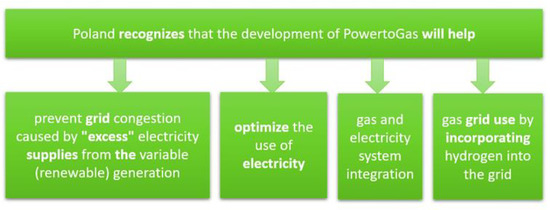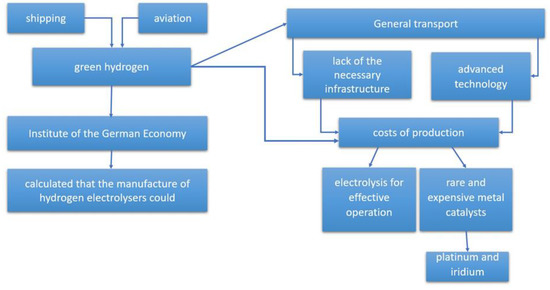You're using an outdated browser. Please upgrade to a modern browser for the best experience.
Please note this is a comparison between Version 1 by Tomasz Jałowiec and Version 2 by Conner Chen.
The use of hydrogen exists in various sectors in Poland and Germany. Hydrogen can be used in industry, transport, decarbonisation of the Polish steel industry and as one of the low-emission alternatives to the existing coal applications in this sector.
- hydrogen
- green energy
- renewable energy
1. Introduction
In Poland, possibilities for using hydrogen exist in all sectors, particularly in industry and the transport sector. In industry, the use of renewable or low-carbon hydrogen in ammonia production and refineries can help reduce greenhouse gas emissions associated with existing hydrogen use [1][2][3][1,2,3].
The deployment of hydrogen can contribute to the decarbonisation of gas supplies in industry and, in the long term, can be used as a low-carbon solution for supplying high-temperature process heat [4][5][6][7][8][4,5,6,7,8].
Hydrogen may be a solution for the decarbonisation of the Polish steel industry, which is currently still dependent on the carbon-based steel production process. In the transport sector, the greatest chances for the implementation of hydrogen lie in the Polish road and rail sector. In the built environment, hydrogen can decarbonise the existing use of natural gas, but it can also be used as a low-carbon alternative to existing coal uses in this sector [9][10][11][9,10,11].
In Poland, the possibilities for using hydrogen in industry are significant. First of all, the Polish industry has a significant market share in the production of ammonia and refining capacity in Europe. These industries already consume hydrogen from fossil fuels, which can be replaced with renewable or low-carbon hydrogen. In addition, natural gas accounts for almost a quarter of the industry’s energy mix, and the use of renewable or low-carbon hydrogen is one way to decarbonise gas supplies [12].
Hydrogen is a low-carbon energy carrier that is well suited to decarbonising this part of the energy demand. Finally, the Polish steel sector accounts for 6% of the EU’s primary steel production and can be decarbonised by switching from conventional fossil fuel-based steel production processes to a process where iron in direct reduction is produced using hydrogen [13][14][15][13,14,15].
The assessment shows that although Poland has included hydrogen as a key transport decarbonisation solution in its National Action Plan to reduce carbon dioxide emissions with several supportive measures, there is still scope to develop a comprehensive framework for the deployment and use of hydrogen in other sectors (construction and industry) [16][17][16,17].
Poland considers hydrogen a key area to be explored as part of its R&D activities to support investments in hydrogen-related production assets, storage and distribution infrastructure, final application, and in the development of materials for energy storage [18][19][18,19].
Poland is the main beneficiary of the Modernization Fund and believes that this funding should be allocated to investments in line with climate policy, to support the implementation of the NECP (National Contact Point—European partnership for clean hydrogen) measures for investments related to hydrogen and fuel cells [20].
Under its NECP, Poland will support national research on clean coal technology (CCT), including the production of hydrogen from coal gasification, to generate electricity using the IGCC (gas combination cycle), or for use in fuel cells [21][22][21,22].
Poland acknowledged that additional measures may be needed to deploy hydrogen refueling stations and encourage the use of hydrogen cars. The NECP also pointed out that the power system faces increasing risks due to the increasing generation of variable power generation, and that there is a need to pay more attention to technologies, such as the use of hydrogen, that allow the integration of these transform sources [23][24][23,24].
2. Hydrogen Planning in Poland
Poland is preparing a hydrogen technology development program aimed at introducing hydrogen applications in the electricity, transport and gas industries, while reducing the consumption of traditional fossil fuels [25][28]. The program covers hydrogen production, transport, storage, distribution and final use, taking into account the EU and Polish legal framework. Hydrogen can become an important area of economic development in Poland [26][29]. The program covers all possible uses of hydrogen, from large factories to homes, and the introduction of hydrogen would fulfill three main objectives: to increase the competitiveness of energy companies; increase the security of the energy supply and benefit the Polish economy as part of the energy transition [27][28][29][30,31,32]. Hydrogen produced from electricity can be sent to the natural gas network and combined with carbon dioxide to produce synthetic methane, thereby improving the quality of biogas. The share of renewable electricity in total electricity consumption will increase from the current 1% to 32% by 2030 [30][33]. Gas-based generation capacity is being developed to support variable generation. Backup power plants are powered by imported gas and domestic resources, including hydrogen. Energy conservation options are also being developed, especially in the field of renewable energy conservation (Figure 1) [31][34].

